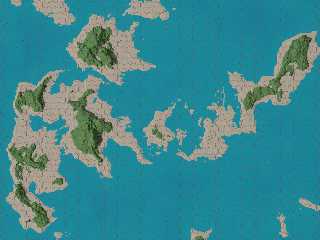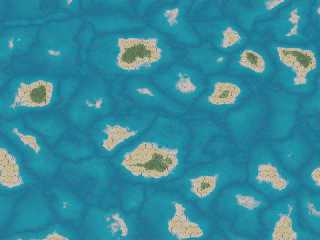 |
 |
|
 |
|
 |
|  |
|  |
|
 |
|
 |
|  |
|  |
|
 |
This one based on wrinkles
Post a reply to this message
Attachments:
Download 'isosurfaces2019_08f1.png' (822 KB)
Preview of image 'isosurfaces2019_08f1.png'

|
 |
|  |
|  |
|
 |
|
 |
|  |
|  |
|
 |
Hi(gh)!
On 23.08.19 12:38, gregjohn wrote:
> This one based on wrinkles
>
Impressive! How did you tweak the wrinkles function to get those wide
coastal plains?
See you in Khyberspace!
Yadgar
Post a reply to this message
|
 |
|  |
|  |
|
 |
|
 |
|  |
|  |
|
 |
Op 23/08/2019 om 12:38 schreef gregjohn:
> This one based on wrinkles
>
That is an interesting scene indeed.
--
Thomas
Post a reply to this message
|
 |
|  |
|  |
|
 |
|
 |
|  |
|  |
|
 |
=?UTF-8?Q?J=c3=b6rg_=22Yadgar=22_Bleimann?= <yaz### [at] gmx de> wrote:
> Hi(gh)!
>
> On 23.08.19 12:38, gregjohn wrote:
> > This one based on wrinkles
> >
> Impressive! How did you tweak the wrinkles function to get those wide
> coastal plains?
>
1. Define a function{pigment{PATTERN turbulence FOO}}
2. Define a function{pigment{function}} based on 1 with a color map which sets
up a nonlinear relationship.
3. Declare a pigment{function}} based on 1, inserting whatever colors you like.
4. Declare an isosurface with function {y-function2} and pigment from 3.
Oh well, I'll just give away the kernel here:
#declare feestruct=
function{
pigment{
function{rawfee(x,y,z).grey}
color_map{
[0 color rgb 0.0]
[sandline color rgb 0.0]
[treeline color rgb 0.1]
[1 color rgb 1]
}
}
} de> wrote:
> Hi(gh)!
>
> On 23.08.19 12:38, gregjohn wrote:
> > This one based on wrinkles
> >
> Impressive! How did you tweak the wrinkles function to get those wide
> coastal plains?
>
1. Define a function{pigment{PATTERN turbulence FOO}}
2. Define a function{pigment{function}} based on 1 with a color map which sets
up a nonlinear relationship.
3. Declare a pigment{function}} based on 1, inserting whatever colors you like.
4. Declare an isosurface with function {y-function2} and pigment from 3.
Oh well, I'll just give away the kernel here:
#declare feestruct=
function{
pigment{
function{rawfee(x,y,z).grey}
color_map{
[0 color rgb 0.0]
[sandline color rgb 0.0]
[treeline color rgb 0.1]
[1 color rgb 1]
}
}
}
Post a reply to this message
|
 |
|  |
|  |
|
 |
|
 |
|  |
|  |
|
 |
gregjohn wrote on 23/08/2019 12:38:
> This one based on wrinkles
>
The image is very nice!
Btw, have you tried to approximate the contours with the hexagons of the
grid? Could also be interesting.
Paolo
Post a reply to this message
|
 |
|  |
|  |
|
 |
|
 |
|  |
|  |
|
 |
Paolo Gibellini <p.g### [at] gmail com> wrote:
> gregjohn wrote on 23/08/2019 12:38:
> > This one based on wrinkles
> >
> The image is very nice!
> Btw, have you tried to approximate the contours with the hexagons of the
> grid? Could also be interesting.
>
> Paolo
Hi, thanks! Here is an update, this one based on dents.
Yes, eventually it would be cool to make the individual structures be merely a
collection of hexagons. Haven't got there yet. com> wrote:
> gregjohn wrote on 23/08/2019 12:38:
> > This one based on wrinkles
> >
> The image is very nice!
> Btw, have you tried to approximate the contours with the hexagons of the
> grid? Could also be interesting.
>
> Paolo
Hi, thanks! Here is an update, this one based on dents.
Yes, eventually it would be cool to make the individual structures be merely a
collection of hexagons. Haven't got there yet.
Post a reply to this message
Attachments:
Download 'isosurfaces2019_09dent5f1.png' (566 KB)
Preview of image 'isosurfaces2019_09dent5f1.png'

|
 |
|  |
|  |
|
 |
|
 |
|  |
|  |
|
 |
Le 19-09-04 à 07:54, gregjohn a écrit :
> Paolo Gibellini <p.g### [at] gmail com> wrote:
>> gregjohn wrote on 23/08/2019 12:38:
>>> This one based on wrinkles
>>>
>> The image is very nice!
>> Btw, have you tried to approximate the contours with the hexagons of the
>> grid? Could also be interesting.
>>
>> Paolo
>
> Hi, thanks! Here is an update, this one based on dents.
>
> Yes, eventually it would be cool to make the individual structures be merely a
> collection of hexagons. Haven't got there yet.
>
Based on dents ? It looks like crackle. com> wrote:
>> gregjohn wrote on 23/08/2019 12:38:
>>> This one based on wrinkles
>>>
>> The image is very nice!
>> Btw, have you tried to approximate the contours with the hexagons of the
>> grid? Could also be interesting.
>>
>> Paolo
>
> Hi, thanks! Here is an update, this one based on dents.
>
> Yes, eventually it would be cool to make the individual structures be merely a
> collection of hexagons. Haven't got there yet.
>
Based on dents ? It looks like crackle.
Post a reply to this message
|
 |
|  |
|  |
|
 |
|
 |
|  |




![]()